Class 11 History Chapter 1 From The Beginning be of Time The answer to each chapter is provided in the list so that you can easily browse throughout different chapters SCERT Class 11 History Chapter 1 From The Beginning be of Time and select need one.
Class 11 History Chapter 1 From The Beginning be of Time
Also, you can read the SCERT book online in these sections Solutions by Expert Teachers as per SCERT (CBSE) Book guidelines. These solutions are part of SCERT All Subject Solutions. Here we have given Assam Board/NCERT Class 11 History Chapter 1 From The Beginning be of Time Solutions for All Subject, You can practice these here.
From The Beginning be of Time
Chapter: 1
EDUCATION
TEXTUAL QUESTION & ANSWER
Q.1 . Look at the diagram sharing The Positive feedback Mechanism on page 13 can you list the inputs that went into tool making ? What were the processes that were strengthened by tool making ?
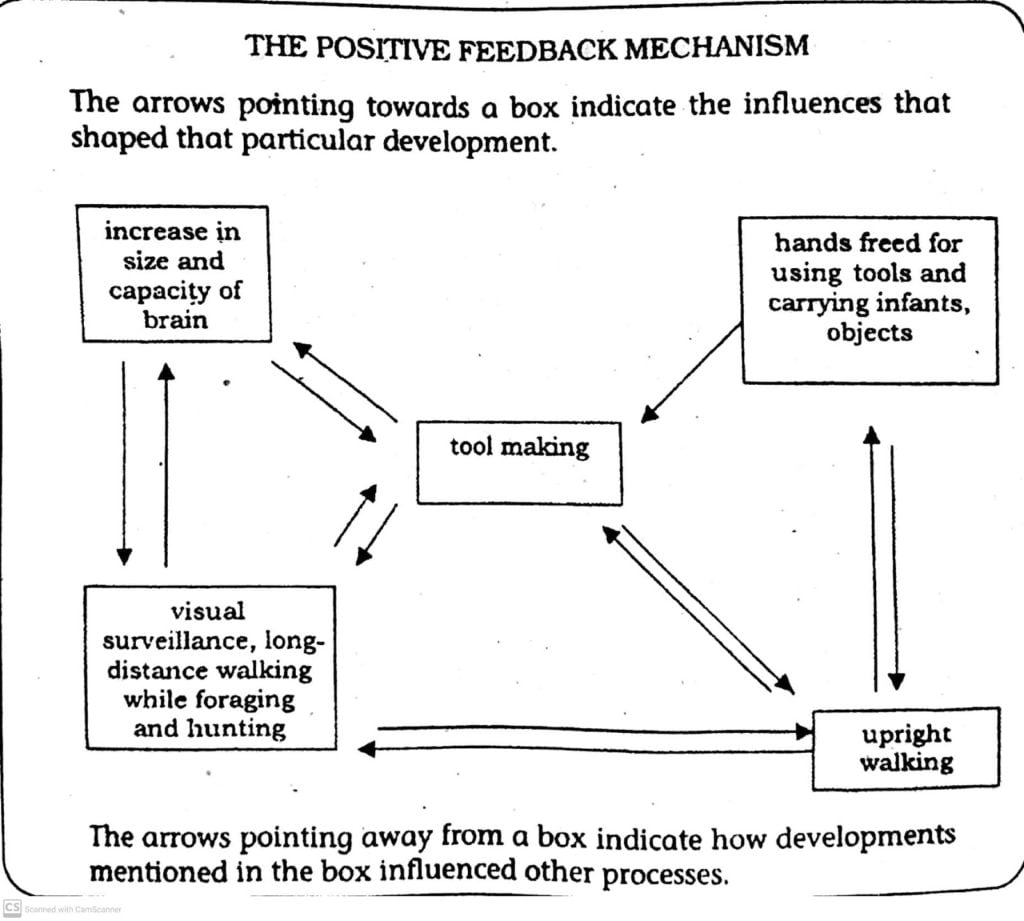
Ans :- The list of inputs that helped in making tools are :-
( i ) large bruin size and increased capability.
( ii ) Long distance walking in search of food and prey.
( iii ) Bipedalism which led to freeing hands so that they could be used for other purposes e.g. making tools.
( iv ) Walking erect. The processes which mere strengthened by the making of tools.
( a ) The capability and mental capacity of man : – As tool making calls for high degree of motor skills, coordination of various parts of the body (eyes, linibs, fingers, etc) as well as enormous concentration and conceptualization.
( b ) Tools making strengthened man’s technical skills :- While early tools made by man (homo-habit es) were rudimentary e.g. oldo wan tools were used mainly for cutting plants, food, breaking units, digging roots, scrapping wood, obtaining honey, skinning meat of animals killed by predators, Home erectus tools were more efficient requiring complex techniques. There was an attempt to impose predetermined design. This strengthened and helped develop accumulated experience and higher level of intelligence.
( c ) Growing efficiency is making tools created conditions for the transition from scavenging to hunting eg. Spear thrower and the bow and arrow. Large quantity of meat could be obtained and stored for later consumption.
( d ) Men could trap fur bearing animals and use the fur for clothing to cover his body and keep the bed warm. Invention of saving needles further contribute to movis dress.
( e ) With the introduction of punch blade techniques to make small chisel like tools it was now possible to make engravings on bone, antler, ivory, and wood. These contributed to development of artistic skills.
( f ) Tools helped primitive man informing, development of agriculture, and to lead a settled instead of nomadic life. Indeed human life is closely linked to development of technology.
Q.2. Humans and mammals such as monkeys and apes have certain similarities is behaviour and anatomy. This indicates that human possibly involved from apes.
List this resemblances in two columns under the headings of
( a ) behaviour and
( b ) anatomy indicate that are there any differences that you think are note worthy?
Ans :- Scientists believe that the gradual evitation of man took place from animals monekeys and apes. Moreover, is scientific terminology both belong to the same order advance primates.
( a ) Similarities in behaviour :
( i ) Both secrete milk and feed their young ones.
( ii ) Both carry their babies with them .
( iii ) Both have the ability to walk upright on their two lower limbs.
( iv ) Both use tools. Chimp sees are known to use tools like sticks to procure insects for food. However, in making tools the humans are unique.
( v ) Both are endowed with the greater understanding as compared to other animals.
( vi ) Both use sound as mode of communication.
( b ) Similarities in Anatomy :
( i ) They have body hair.
( ii ) They are warm blooded and have the ability to maintain a constant body temperature.
( iii ) Females give birth to live off spring and have a relatively long gestation period following birth.
( iv ) Females of the species have man mary glands which secrete milk to feed the young.
( v ) They have a backbone which a column of discs enclosing the spinal cord. This column gives internal support to the body.
( vi ) They have different types of teeth.
( c ) Differences between them :
( i ) While apes too use tools (e.g. sticks) unlike humans they do not use them on a regular basis and are certainly not able to make specialized tools e.g. stone tools.
( ii ) Monkeys and apes as compared to humans who are bipeds are quadriped. They can stand and walk upright on their lower limbs for short period only. Moreover, they rely on their chucks to assist them in walking.
( iii ) Unlike humans monkeys and apes have features which allow them to climb and move about on trees with great ease i.e. prehensile hands and feet adapted to graspings. They use their for limbs quite extensively.
( iv ) Monkeys and apes have a stereoscopic vision which helps them gauge distance and depth.
( v ) In apes the back bone is inward curving or concave (shaped). Human backbone is ‘s’ shaped.
( vi ) Human brain is globular and bigger while that of apes is smaller and elongated. However, jaws of apes are stronger than that of human.
( vii ) While both use sound as mode or communication human vocal chords have the ability to make a greater variety of sounds. These can be combined in an infinite number of ways. This is reflected tritan the vast number of languages that human societies have produced,
(viii) Apart from difference in shape and size human brain is differently arranged for it has the capacity to accumulate information, develop thought, and imagination. This is reflected is practice of various arts like painting, tool making, engravings etc.
Q.3. Discuss the arguments advanced in favour of the regional continuity modes of human origins. Do you think it provides a convincing explanations of the archaeological evidence? Give reasons for your answer.
Ans :- A. Arguments advanced in favour of :- While it is generally agreed harmony were as much a product of evolution as other loving organisms the issue of place of origin of humans has been a topic of much debate. Two totally divergent views have been expounded. The first theory believes in regional continuity model. According to this view point men has multiple regions of origin. The other the “Replacement model,” holds the view that men had a single origin in Africa and from there spread to other parts of the would. Arguments meted out in favour or “Regional Continuity Model” are-
( i ) Differences in the time at which Homosapiens came into being in different places. In support are finds of fossils of modern human.
( a ) Ethiopia – 1,95,000-1,60,000 years ago (omo Kibish)
( b ) Morocco – 70,000-50,000 years ago (Dar-es-sollen)
( c ) Australia – 45,000-35,000 years ago (lake mango)
( d ) Borneo – 40-000 years ago (Niah come)
( e ) France – 35,000 years ago (cro Magnon)
( ii ) Variations in appearance of early humans in different parts of the world. For example, corroborated by archaeological finds of “Java Man” “Heidelberg man,” “Homo neanderthalensis” and “Peking man”.
( iii) Differences in features of present day humans.
B. Replacement Model:- Which the Regional Continuity Model has its points in place, the Replacement model cannot be washed away.
Arguments in place as per the Replacement model are:- The earliest hominid fossils have been found in East Africa and date back to 5.6 my a (genus “Australopithecus or say “Homo habit is at Omo in Ethiopia). In contract fossils found outside Africa are no other than 1.8 Mya.
(ii) Genetic and anatomical homogeneity of modern dancers (DNA etc). They argue enormous similarities amongst modern hormones i.e, due to their descent from a population that originated in the single region-Africa.
( iii ) Regarding physical differences this view suggests differences observed today are the result of adaptation spread over a thousands of years by population who emigrated to the particular regions where they finally settled down.
Q.4. Which of the following do you think is best documented in the archaeological record
( a ) Gathering
( b ) Tool making
( C ) The use of fire?
Ans : – (a) Gathering, (b) tool making and (c) the use of fire, tool making is best documented in archaeological record.
( a ) Gathering :- Gathering involved collecting plant foods such as seeds, nuts, berries, roots and tubers. That gathering was practiced generally is assumed, than conclusively established as there is very little direct evidence for it. Fossilized plant remains are relatively rare. Also, so far archaeological have not foùnd much evidence of carbonised seeds for this very early period.
(b) Tool making :- Tools are best documented in archaeological records they help not only reconstruct evolution of modern humans but also his development, culture and as vilization. The progress They have been an integral part of the adapting strategy of genus “Lomo” Lomo for 2.5 millions years.
Examples : “old own” store culture was discovered by Louis and Mary Leakey established modern human ancestors “homohabilis” became tool makers in east Africa. These small, crude, rudimentary tools mark the beginning of Paleolithic age.
( ii ) Tools made by Homo erectus, make a stage in the evolution of modern humans as the archaeological remains of tools chopper, flake tools to hand are, spear thrower, were more efficient and standard sized, requiring greater skill and concentration introduction. They mark improvements in techniques for hilling animals.
( iii ) Invention of sewing needles enabled human to use the fur for clothing and punch blade technique to make small ‘chisel like tools made possible to make engraving on bone antler ivory or wood (i.e. develop artistic instincts).
(iv) Thus, evolution of human from Australopithecus to ‘Homo’-homo habilis Homo erectus, Homo sapiens and Homo Sapiens (modern human) and from scavengers to hunter and producer each are archaeologically recorded in tools.
( c ) Use of Fire :- There are two main findings which archaeologists conclude use of fire among early humans –
( i ) Hearths and
( ii ) Pieces of burnt clay and burnt bone along with stone tolls dated too between 1.4 and 1.2 mya.
( i ) Hearths :- In Lazaret cave in southern frame hearth have been excavated. These point to controlled use of fire for various purposes like cooking, heating, lighting, hardening wood, flaking tools or to ward off dangerous animals.
( ii ) Regarding pieces of burnt clay and burnt bone we do not know whether these where a result of natural bush fire or volcanic eruption or they were produced through deliberate controlled use of fire. Thus regarding use of fire or volcanic eruption or they were produced through deliberate controlled use of fire. Thus regarding use of fire our knowledge is at presents limited.
ANSWER IN SHORT ESSAY
Q.5. Discuss the extent to which (a) hunting and (b) construction shelters would have been used for there activities?
Ans :- Earth man was a food gatherer and scavenger. These where More of an individual activity. With homo erectus cultures social groups became large and man matured from being a scavenger to hunter.
( a ) Hunting :- Hunting require more co-operation as large animals could be tracked and killed more efficiently with enhanced cooperation. Such cooperation was felicitated by use of language. The hominid language involved gestures or hand movements. The oral language was preceded by non verbal communication such as humoring or singing or probably coegun with calls like the eves that are observed among primates. These probably gradually developed into language around 40,000 to 30,000 years ago.
( b ) Construction of shelters :- construction of shelters was not a single man job. He needed many hands to do so. This was facilitated by the use of language. Bands moved over a large territory in a seasonal cycle. During each season they selected an appropriate site as their “home base” From this home base small groups ventured forth in different directions for the purpose of hunting animals. This arrangements involved division of labour within the bands.
While males went for hunting, women and children stayed close to ‘home case’ tending children and gathering plant for food. These bands congregated on certain occasions for performing rituals, exchanging objects and mating partners. These activities too were facilitated by use of language.
( c ) Other modes of communications:- For hunting and constructing n shelters art of painting could have been used, besides language as yet another mode of communication. Through the medium of art, man could express his ideas and emotions. Many painting depicting animals (Which include bison, rhino’s horses, deer, etc.) have been discovered in the caves of Lascaux and Chauvet in France and Alta mire in Spain .
Yet another viewpoint is through paintings groups sought to share hunting techniques, or pass informațion from one generation to another.
| Sl. No. | সূচী-পত্ৰ |
| Chapter 1 | From The Beginning be of Time |
| Chapter 2 | Writing & City Life |
| Chapter 3 | An Empire Across Three Continents |
| Chapter 4 | The Central Islamic Lands |
| Chapter 5 | Nomadic Empires |
| Chapter 6 | The Three Orders |
| Chapter 7 | Changing Cultural Traditions |
| Chapter 8 | Confrontation of Cultures |
| Chapter 9 | The Industrial Revolution |
| Chapter 10 | Displacing Indigenous People |
| Chapter 11 | Paths to Modernization |
Q.6. Chose any two developments each from Timelines 1 and 2 at the end of the chapter and indicate why you think these are significant.
Ans :- Time Line 1
( a ) Earliest Stone Tools :- Chopper, flakes, hard axe. The earliest evidence of making and use of stone tools comes from sitey in Ethiopia and Kenya and it is likely that the earliest makers of S stone tools were Australopithecus.
Significance : –
( i ) Reflect certain anatomical and neurological developments in early man as making of tools require skilled use of hands, development of memory and complex organizational skills.
( ii ) Proficiency and efficiency in stone tool making shows efficiency in stone tool making animals e.g. shape of hand axe.primarily used for processing meat could have been thrown like a discuss for hunting prey as well as for defence against preuators.
( iii ) Introduction of punch blade techniques let to production of blade that could be used as knives or modified to serve as chisels or burins which could be used to engrave bone, antler, ivory or wood.
( iv ) The growing efficiency in tool making made possible transition of humans from scavengers and gatherer to hunters; and later cultivators/producers.
( v ) Stone tools help reconstrnetion of evolution of modern humans.
( b ) Cooling drying of Africa resuiting in the decrease in woodlands and increase in grasslands.
Significance :-
( i ) led to the gradual extinction of the early forms of Australopithecus (that were better adapted to forests)
( ii ) Replacement of Australopithecus by species that was better adapted to drier conditions – genus homo.
( iii ) The ablest fossils of genus “homo” is that of “homo habilis” olduvi in Tanjania brain was larger than that of Australopithecus, and was a tool maker.
Or
( b ) Homo erectus : fossils date to 1.8 mya. Significance:- Emergence of “Homo habilits” was followed by emergence of another species of homo. “homo erectus” (East Turkma in kenya)
( i ) Marked further step forward in evolution of modern man. Homoerectue was almost like modern human beings.
( ii ) Apart from bipedal locomotion and wall developed hands it had a large brain.
( iii ) Made tools with greater skill, were more accumulated experience and high level of intelligence.
( iv ) From this time homo began to move out of Africa into Asia and Europe.
2. Timeline : –
(a) Evidence of figures made of fired city (27,000 years ago) A member of clay figures portray the human female body. They have seen discovered at sites in Europe, Africa and Siberia.
Significance:-
( a ) Reflect development of thought and imagination.
( ii ) ) Early man was an artist.
( iii ) Use of fire
( iv) Figures were probably connected with rituals which meant to promote fertility.
( v ) Some historians interpret these figures led to development of mother goddess cults which were so characteristic of agrarian societies.
( b ) Development of voice box (200,2000 years ago)
Evolution of the species ‘Homo sapines’ were marked by modifications in the shape of the neck-the sound resulting portion of our throats.
Significance :
( i ) It enabled humans to produce a wide variety of sounds. Though other primates as well as other animals communicate by producing sounds, modern humans are unique in the variety of sounds by they can produce due to the voice box.
( ii ) These sounds in turn enabled man to innovate and combine them in infinite number of ways which is reflected in the vast number of languages that humans societies have produced.
( iii ) Language in turn facilitated in this capacity to arrange ideas, transmit knowledge and information to successive genetrations in a manner not possible for other animals.
( iv ) Each generation need not start from scratch but can build upon aceumulated experience of previous generation. A more developed brain allowed this information to be stored.
( v ) Accelerated the pace of cultural adaptation among human.
Or
( C ) Invention of securing needs ( 21,000 years ago) Significance :
( i ) Step forward in the life or early man.
( ii ) While very early man roamed around naked inventing a needle made it possible for him to sew his clothes from skins and furs of anímals and protect himself from the harsh cold.
TEXT BOOK ACTIVITIES
Activity-1: List as many similarities and differences that you notice (in the NCERT text book) looking carefully at the brain are, jaws and teeth.
Ans :- A. Similarities
( i ) Belong to the same order, order or primates.
( ii ) Reflect the evolution of man
B. Differences
Fig A (Ape) :

( i ) Belongs to the sub group the super family hominsida:- ponojida (apes)
( ii ) Targe amine both.
( iii ) Snout is bigger.
(iv) Skill is elongated and less brain size .
( v ) Eyes close to each other, at the front of the skill (not on the sides)
( vi ) Broad neek space.
[ Fig B, C and D: belong to the subgroup of the super family toe hominoid homicide EPI note: of the hominide (our own species) which are devided into genus. ‘antralopi theeus’ and genus “homo” Australopithecus was first to evolve]
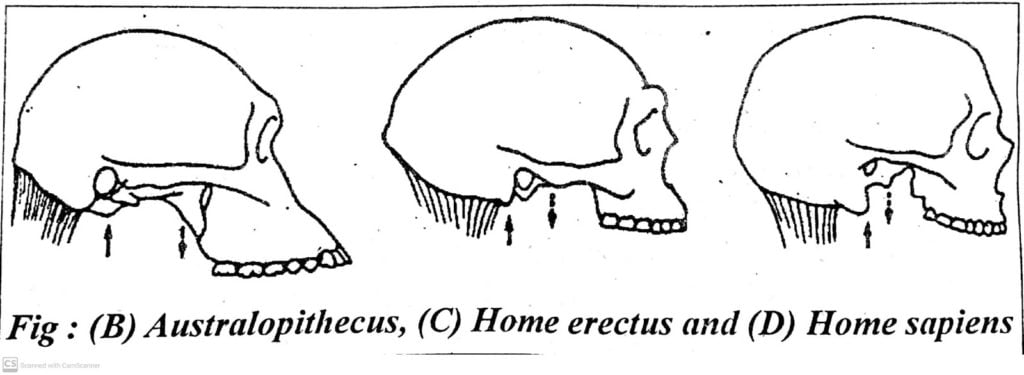
Fig B (Australopithecus) Ethiopia Omo valley, Hadar)

( i ) This species still retained some characteristics of the apes.
( ii ) Brain size was not very difference from that of the apes.
( iii ) Check teeth of Fig B as compared Fig A are flatter which suggests they were adapted grindsing through plant food rather than soft food.
( iv ) Canines reduce its size.
( v ) Jaw lighter as compared to Fig. A
Fig C (Homo erectus) (East Turkanna Kenya) :
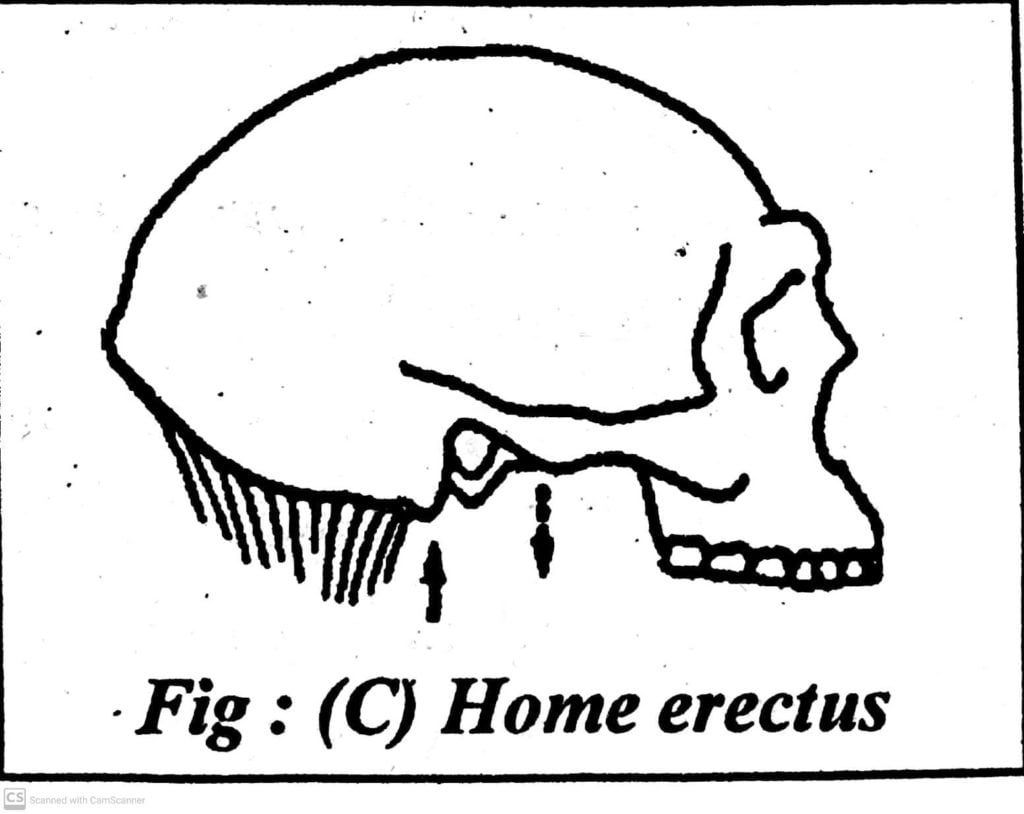
( i ) Almost like modern human beings.
( ii ) Skull thicker and less rounded at the top (low and bulging)
( iii ) Large brain size.
( iv ) Jaws with reduced outward protection.
( v ) Smaller teeth.
( vi ) Eye sockets on the sides.
Fig D. (Homo sapiens) Broken hill, Sambil/ero Magnon, France):
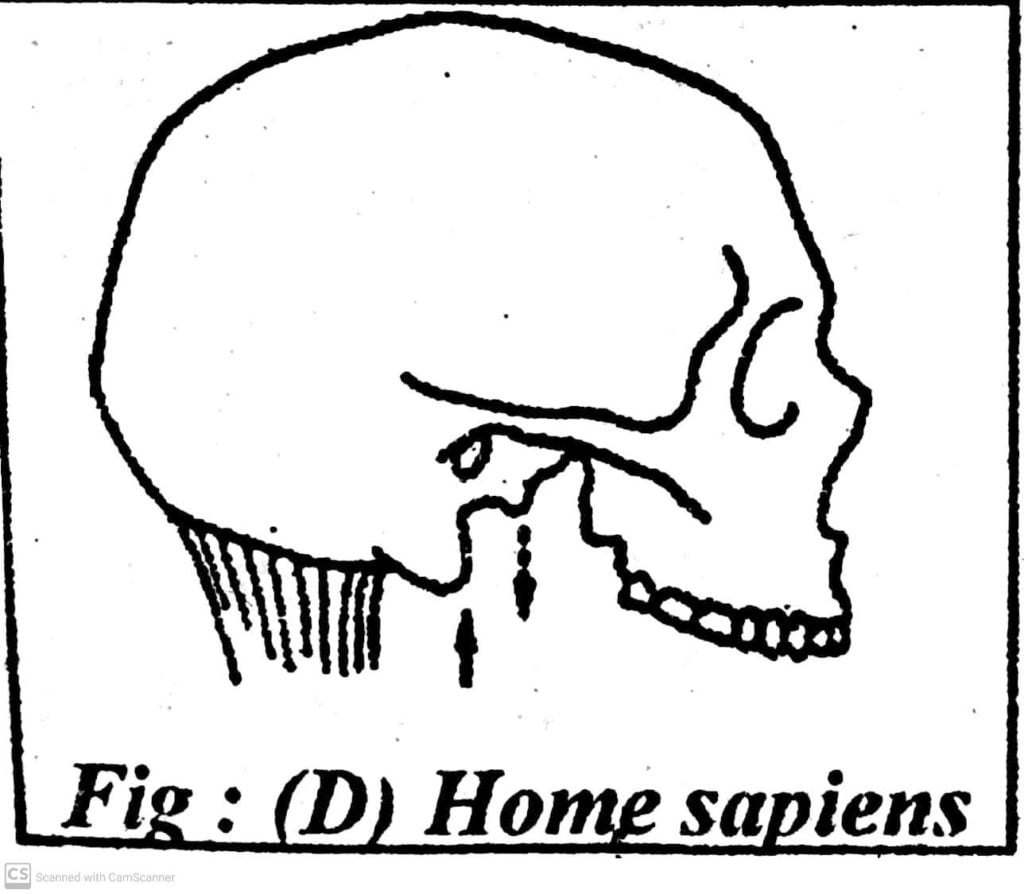
( i ) Like modern human beings.
( ii ) Increased brain size .
( iii ) Globular shape of the skull.
( iv ) Smaller teeth.
( v ) Eyes placed on the sides.
( vi ) Modifications is the shape of the neck most important the sound resonating portion of our throats.
Activity Evolution of the Hand:
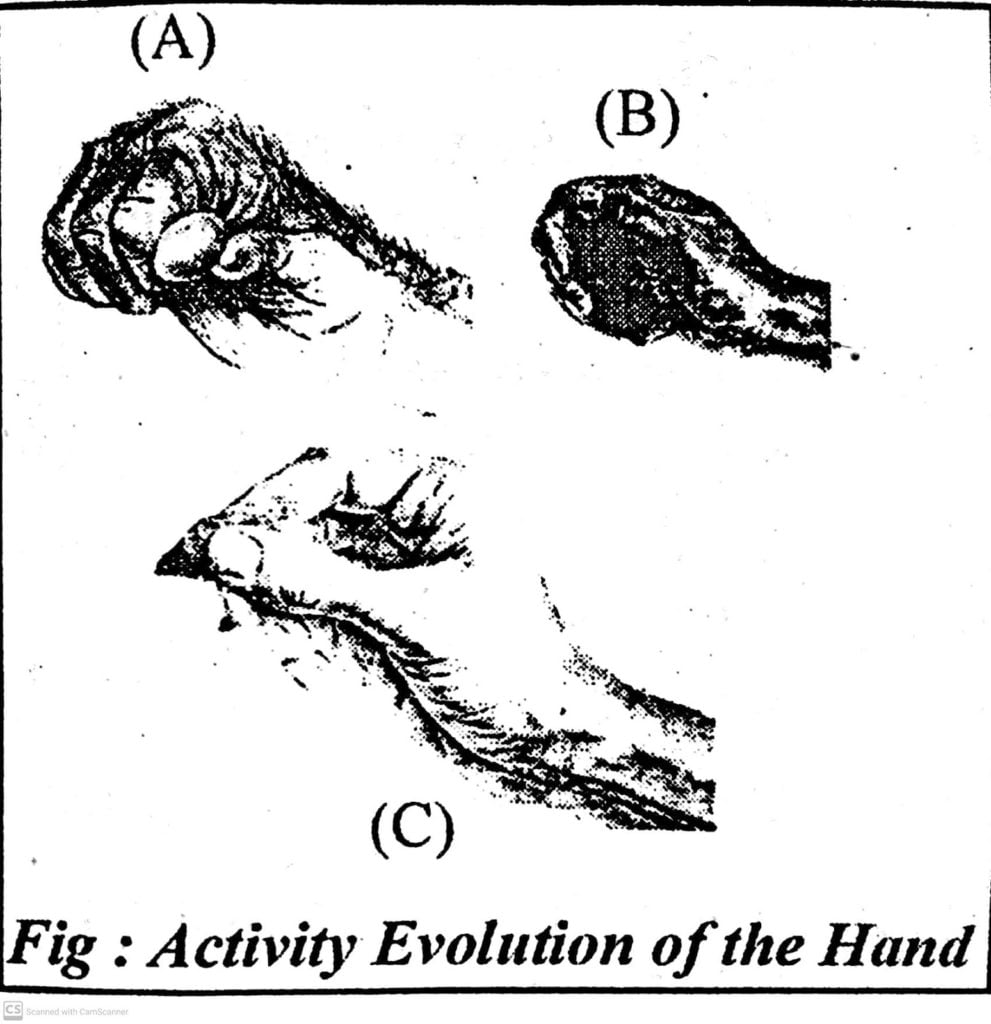
Short Answer :-
( i ) Compare the hand of a the chimpanzee with that of the hominid. Give four differences.
Ans :- Chimpanzee as compared to the hominid hand :-
(a) a very hairy hands.
(b) curved fingers.
(c) Limited decertitfy.
(d) Flattened nails.
(e) Thumb of the hand is opposed it the forefinger.
( ii ) Make a list of things you do using a precision grip.
Ans :- Precision Group :-
(a) Threading a needle .
(b) Hoking a pen/ pensil and writing.
( iii ) What are the things you do using a power grip?
Ans :- Power Grid :-
(a) Squeezing.
(b) Holding a ball .
( iv ) Computer the compared to the chimpanzee with that of the human hand.
Ans :- The precision grip of the chimpanzee is limited as compared to the human hand due to curved fingers and placement of the thumb.
Reconstruction of a that at Terra Amata :
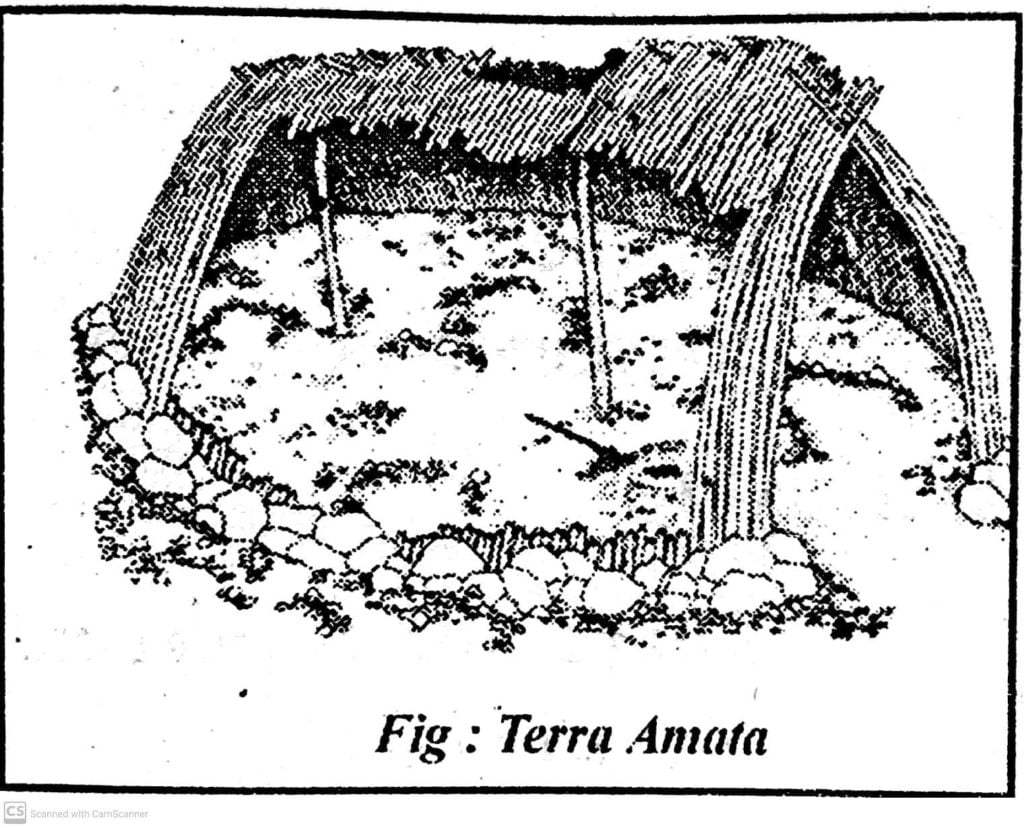
1. Whom do you think this shelter belongs to?
Ans :- The shelter belongs to early humans who started living in caves and open air sites between the period 400,000 and 125,000 years.
2. Try and identify the site.
Ans :- Site : Terra Amanta on the coast of Southern France.
3. What do you think are the materials used for construction?
Ans :- Materials : (a) Wood and grasses (b) large stone boulders are used to support the sides of the hut.
4. What are the scattered stones undicate of?
Ans :- As per archaeologists the scattered stones on the floor were places where people make stone took.
5. In what ways do you think life those who lived in this shelter would be different from that of the hominid who lived on trees?
Ans :- Hominids on trees : (a) Exposed to the vagaries of nature e.g. rain Sun.
(b) had to probably share the location with others-primate and carnivores.
(c) As suggested by archaeologists. Hominids who lived on trees probably consumed most of the food where they formed it, slept in different places and spent much of their time in trees.
Hominids in Shelter: Unlike hominid who lived on tress those, who lived in shelters.
( i ) Cooked and consumed food, lived slept and worked in these shelters for e.g. in the lazaret cave in Southern France evidence of 2 hearths and difference food sources have been recovered.
( ii ) The hearth in these shelters provided warmth and light inside caves.
( iii ) Apart from cooking, fire facilitated the flaking of tools.
( iv ) These shelters provided security and safety from dangerous animals, and vagaries of nature.
( v ) Enabled a more settled life, facilitated more interaction communication, development of language and artistic skills.
Activity 4: These are representations of some of the early tools Identify them.
Ans :- (a) Chopper and (b) Handaxe
( a ) The chopper a large stone from which flakes have been removec was probably used as a working edge Flakes-Used as knives fo- cutting plant food, breaking nuts, digging roots, scrapping wood skinning the meat or animals killed by other predators or extracting bone marrow.
Modified to serve as chisels or burins which could be used to engrave bone, antler, ivory or wood.
( b )Hand axe :- (Note core tool of Homo erectus)
Primarily used for processing meat For skinning and as meat chopper Weapon which could have been thrown like a discuss Shape of the hand axe is such as could be used for hunting prey as well as for defence against predators.
It needs to be noted that the earliest stone tool makers were th Austrolopi he clans. Growing efficiency in tool making skill- mode conditions for transition of early humans from being scavengers to hunters.
( iii ) Can you suggest what these tools may have seen used for Give names of two sites from which evidence for the making 2. 3. and use of stone tools have been discovered.
( iii ) Sites : Omo in Ethiopia : Oldavia Gorge in Tan Zania.
Activity-5

Questions:-
( i ) Identify the object
Ans :- (i) Archaeologists identify it as a spear thrower.
( ii ) How was it used?
Ans :- Hunters used the tool to hurl spears over long distances.
( iii ) Can you suggest any advantage in using such equipment.
Ans :- Advantages :
(a) It was a lethal and effective tool for hunting big wild animals.
(b) useful tool for deviance against predators.
( iv ) What does use of such tool indicate? Give two points.
Ans :- Indicates :
(a) Improvements in techniques for killing animals .
( b ) Growing efficiency in making tools made conditions for transition from scavenging to hunting.
The meat thus obtained was probably processed by removing the bones followed by drying, smoking and storage. Thus food could be stored for later consumption.

Hi, I’m Dev Kirtonia, Founder & CEO of Dev Library. A website that provides all SCERT, NCERT 3 to 12, and BA, B.com, B.Sc, and Computer Science with Post Graduate Notes & Suggestions, Novel, eBooks, Biography, Quotes, Study Materials, and more.


